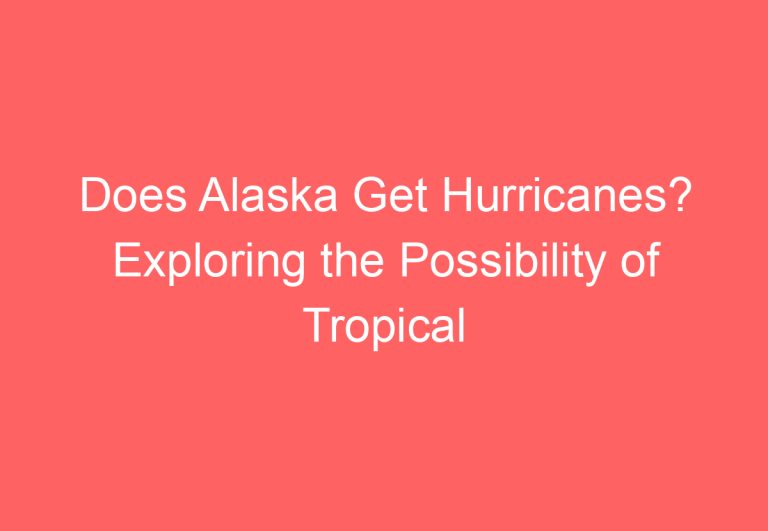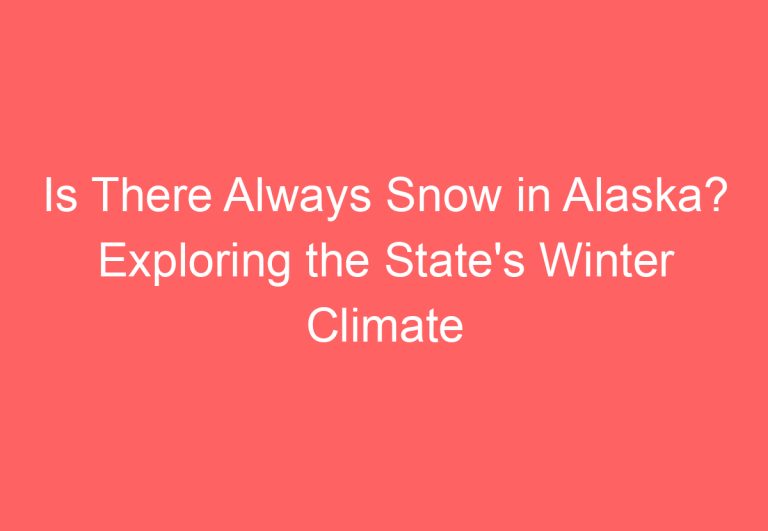How Much of Alaska is Uninhabited: A Comprehensive Analysis
Alaska is the largest state in the United States, covering a vast area of 663,268 square miles. Despite its massive size, Alaska is home to a relatively small population of approximately 731,000 people, making it the least densely populated state in the country. With its rugged terrain and harsh climate, much of Alaska’s land remains uninhabited and untouched by human activity.

The percentage of Alaska designated as federal land is approximately 60%, with the remaining land owned by the state and private entities. This means that a significant portion of the state’s land is protected wilderness, including national parks, forests, and wildlife refuges. These areas provide important habitat for a wide variety of wildlife, including grizzly bears, wolves, caribou, and moose.
Mapping the exact percentage of Alaska that is uninhabited is challenging due to the state’s vast size and rugged terrain. However, according to data from the 2010 Census, Alaska is one of the most sparsely populated states in the country, with only 1.3 people per square mile. This means that much of the state’s land is uninhabited and provides a unique opportunity for visitors to experience the natural beauty of the Last Frontier.
Geography and Demographics of Alaska

Population Distribution and Density
Alaska is the largest state in the United States by land area, covering an area of 663,268 square miles. However, it is the least densely populated state, with a population density of only 1.3 people per square mile. The population of Alaska was estimated to be 738,068 in 2020, making it the 48th most populous state in the country.
The majority of Alaska’s population is concentrated in the urban areas of Anchorage, Fairbanks, and Juneau. Anchorage is the most populous city in Alaska, with a population of 291,538. Fairbanks is the second-largest city in the state, with a population of 31,516. Juneau, the capital city of Alaska, has a population of 32,434.
Major Cities and Remote Areas
Alaska is known for its vast wilderness and remote areas. The state has a few major cities, but much of its land is uninhabited. The state’s largest city, Anchorage, is located in the south-central part of the state and is home to around 40% of Alaska’s population. Other major cities in Alaska include Fairbanks and Juneau.
Despite its large size, much of Alaska’s land is uninhabited due to its harsh climate and rugged terrain. The state’s remote areas are home to several indigenous communities, including the Inupiat, Yupik, and Aleut peoples. The state also has many national parks and wildlife refuges, which are home to a wide variety of plant and animal species.
Overall, Alaska’s unique geography and demographics make it a fascinating and diverse state to explore. Its vast wilderness areas and remote communities offer visitors a chance to experience a different way of life, while its urban centers provide all the amenities and conveniences of modern living.
Natural Landscape and Uninhabited Regions

Alaska is known for its rugged and remote natural landscape, which is largely uninhabited. The state’s vast size and harsh climate make it inhospitable to human habitation in many areas, resulting in large swaths of uninhabited land.
Wilderness and Wildlife
Alaska’s wilderness areas are among the most pristine and untouched in the world, with vast stretches of tundra, forests, and glaciers. These areas are home to a wide range of wildlife, including grizzly bears, wolves, moose, and caribou. Hunting and fishing are popular activities in these areas, and many visitors come to Alaska specifically to experience the state’s unique wilderness and wildlife.
Conservation and Protected Areas
Alaska’s remote areas are also home to a number of protected areas, including national parks, wildlife refuges, and national forests. These areas are managed by the federal government and are designed to protect the state’s unique ecosystems and wildlife. Some of the most well-known protected areas in Alaska include Denali National Park and Preserve, the Arctic National Wildlife Refuge, and Tongass National Forest.
Conservation efforts in Alaska are particularly important given the state’s vulnerability to climate change. Rising temperatures and melting glaciers are already having a significant impact on the state’s ecosystems and indigenous peoples, and conservation efforts are needed to protect Alaska’s unique natural resources for future generations.
Frequently Asked Questions

What percentage of Alaska’s land area remains unpopulated?
Alaska is the largest state in the United States, covering over 663,000 square miles. According to recent estimates, approximately 80% of Alaska’s land area remains unpopulated. This is due to a variety of factors, including the state’s harsh climate, rugged terrain, and vast wilderness areas.
How does the wilderness area in Alaska compare to its overall land mass?
Alaska’s wilderness area is vast and covers approximately 57 million acres, which is equivalent to about 60% of the total wilderness area in the United States. This is a significant proportion of the state’s overall land mass and contributes to the large areas of uninhabited land in Alaska.
What factors contribute to the large areas of Alaska being uninhabited?
Several factors contribute to the large areas of uninhabited land in Alaska, including the state’s harsh climate, rugged terrain, and vast wilderness areas. In addition, Alaska’s population is relatively small, with most of its residents concentrated in urban areas such as Anchorage and Fairbanks.
How does the inhabited land in Alaska compare to its total size?
Despite its large size, Alaska’s inhabited land area is relatively small. In fact, only a small percentage of the state’s total land area is inhabited, with most of the population concentrated in urban areas such as Anchorage and Fairbanks.
In terms of exploration, what proportion of Alaska is still considered uncharted?
Despite centuries of exploration, a significant proportion of Alaska is still considered uncharted. In fact, it is estimated that only a small percentage of the state’s total land area has been explored and mapped.
What are the primary reasons for the low population density in Alaska?
The primary reasons for the low population density in Alaska include the state’s harsh climate, rugged terrain, and vast wilderness areas. In addition, the state’s remote location and limited economic opportunities also contribute to the low population density.






